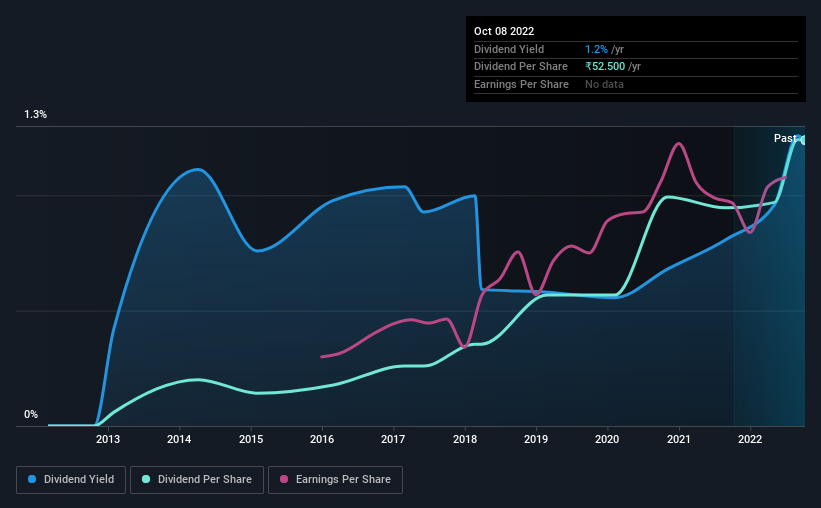Procter & Gamble Health's (NSE:PGHL) Dividend Will Be Reduced To ₹11.50

Procter & Gamble Health Limited's (NSE:PGHL) dividend is being reduced from last year's payment covering the same period to ₹11.50 on the 23rd of December. The yield is still above the industry average at 1.2%.
See our latest analysis for Procter & Gamble Health
Procter & Gamble Health's Dividend Is Well Covered By Earnings
Impressive dividend yields are good, but this doesn't matter much if the payments can't be sustained. Based on the last payment, Procter & Gamble Health was quite comfortably earning enough to cover the dividend. This means that a large portion of its earnings are being retained to grow the business.
Looking forward, earnings per share could rise by 19.3% over the next year if the trend from the last few years continues. Assuming the dividend continues along recent trends, we think the payout ratio could be 48% by next year, which is in a pretty sustainable range.

Dividend Volatility
The company's dividend history has been marked by instability, with at least one cut in the last 10 years. Since 2012, the annual payment back then was ₹2.50, compared to the most recent full-year payment of ₹52.50. This means that it has been growing its distributions at 36% per annum over that time. Dividends have grown rapidly over this time, but with cuts in the past we are not certain that this stock will be a reliable source of income in the future.
The Dividend Looks Likely To Grow
With a relatively unstable dividend, it's even more important to evaluate if earnings per share is growing, which could point to a growing dividend in the future. It's encouraging to see that Procter & Gamble Health has been growing its earnings per share at 19% a year over the past five years. Earnings are on the uptrend, and it is only paying a small portion of those earnings to shareholders.
We Really Like Procter & Gamble Health's Dividend
In general, we don't like to see the dividend being cut, especially when the company has such high potential like Procter & Gamble Health does. The cut will allow the company to continue paying out the dividend without putting the balance sheet under pressure, which means that it could remain sustainable for longer. All in all, this checks a lot of the boxes we look for when choosing an income stock.
Investors generally tend to favour companies with a consistent, stable dividend policy as opposed to those operating an irregular one. Still, investors need to consider a host of other factors, apart from dividend payments, when analysing a company. Just as an example, we've come across 2 warning signs for Procter & Gamble Health you should be aware of, and 1 of them is potentially serious. Looking for more high-yielding dividend ideas? Try our collection of strong dividend payers.
If you're looking to trade Procter & Gamble Health, open an account with the lowest-cost platform trusted by professionals, Interactive Brokers.
With clients in over 200 countries and territories, and access to 160 markets, IBKR lets you trade stocks, options, futures, forex, bonds and funds from a single integrated account.
Enjoy no hidden fees, no account minimums, and FX conversion rates as low as 0.03%, far better than what most brokers offer.
Sponsored ContentNew: Manage All Your Stock Portfolios in One Place
We've created the ultimate portfolio companion for stock investors, and it's free.
• Connect an unlimited number of Portfolios and see your total in one currency
• Be alerted to new Warning Signs or Risks via email or mobile
• Track the Fair Value of your stocks
Have feedback on this article? Concerned about the content? Get in touch with us directly. Alternatively, email editorial-team (at) simplywallst.com.
This article by Simply Wall St is general in nature. We provide commentary based on historical data and analyst forecasts only using an unbiased methodology and our articles are not intended to be financial advice. It does not constitute a recommendation to buy or sell any stock, and does not take account of your objectives, or your financial situation. We aim to bring you long-term focused analysis driven by fundamental data. Note that our analysis may not factor in the latest price-sensitive company announcements or qualitative material. Simply Wall St has no position in any stocks mentioned.
About NSEI:PGHL
Procter & Gamble Health
Engages in the manufacture and marketing of pharmaceuticals and chemical products in India and internationally.
Flawless balance sheet with proven track record and pays a dividend.
Similar Companies
Market Insights
Community Narratives



